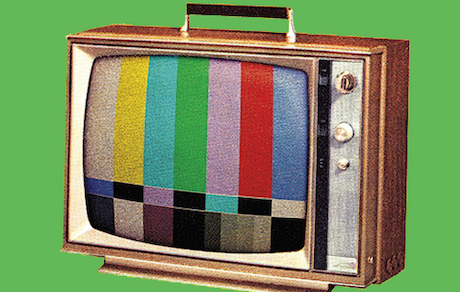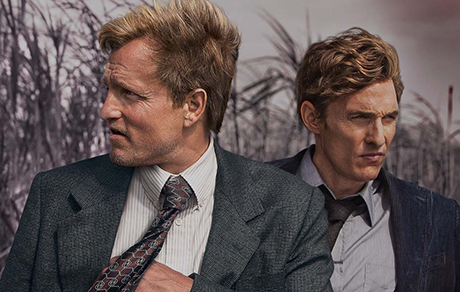David Bianculli's Curator Essay
If you apply the familiar concept "you are what you eat" to television - and it becomes "you are what you watch" - then TV critics are in trouble. We watch more television than you do, no matter how much you watch, and, unlike you, have to keep watching the bad stuff once we decide it's no good.
And if you accept Malcolm Gladwell's concept of the "10,000-Hour Rule," that it takes 10,000 hours working in a specific field before a person can be considered an expert, then, by that yardstick, I'm about four experts. I've been a professional TV critic for almost 40 years - and a TV viewer for 60.
The exhibition Bianculli's Personal Theory of TV Evolution attempts to explore and merge both of those concepts. As a TV historian, I connect television past and present, using video clips, still photos, and other means, tracing the evolution of such themes as "Single Working Women on TV," "Animation on Television," and "Superheroes Throughout TV History." And as a lifelong TV viewer and fan, I identify the programs and events that most impressed, shaped, and even warped me a little.
I'm taking the Personal part of the title very seriously. As a TV critic, some of the connections I make, and some of the video snippets I showcase, are highly personal indeed. Who else would insist upon making room for both Ernie Kovacs and Dennis Potter, or approach The Beatles on The Ed Sullivan Show and the Red Room on Twin Peaks with equal reverence? Even more personally, I'm exploring, explaining, and confessing my own lifelong relationship with television. I enjoy being a TV critic. It's a job that always changes, that demands you flex different muscles on different days, and that occasionally rewards you with brilliant, wonderful programs, some of which can enrich, and even change, your life. I've said for decades that sooner or later, everything I care about shows up on television, giving me the opportunity to write about music, theatre, politics, literature, comedy - anything telecast by anyone is fair game.
As I began gathering items for this gallery exhibition, I finally realized that the key was to approach this event the way I approach my work as a critic and as a professor: I take what I do very seriously, but don't take myself very seriously. So anyone attending this exhibit in person, I want you, and expect you, to have fun. If the first few things you examine don't spark any smiles, musings, or memories, keep going - something else, on another wall, in another part of the installation, is bound to strike your fancy.
Show up, and you get to witness, up close and personal, Saint Clare the glow-in-the-dark patron saint of television, and the actual snow globe from the controversial finale of St. Elsewhere - a valuable item lent to the exhibit by a private collector, just like a real piece of art at a real curated museum exhibition. Which, I have to keep reminding myself, this is.
As they say on late-night TV, "But Wait! There's More!"
For example, one of my favorite elements in this exhibition is a giant blow-up of a video still from a 1961 edition of The Ernie Kovacs Show on ABC. What you see is a man in a horse costume pointing a gun that's tied to an outstretched hoof - without any idea what it's connected to. But next to it plays an endless loop of the eight-minute sketch in which Kovacs, acting unofficially as the first TV critic on TV, deconstructs the then-pervasive craze of TV Westerns. The museum-style plaque next to the "Rancid the Devil Horse" will tell you why I love this particular few seconds of vintage television so much, and how I teach it to my TV History & Appreciation students at Rowan University.
What you get out of this exhibit, then, depends on where you place your attention and for how long. Think of it as changing channels if you're not interested, and staying glued to the tube if you are. The centerpiece of the exhibit is a "video wall" showing the progression of different topics through television's history, or my history with television. Watch a while, listen on headphones if something catches your eye, walk around to other parts of the exhibit, and return to sample a little more. It's all around you, waiting for you to "tune in."
By 1988, when PBS presented Bill Moyers' six-part interview with mythologist Joseph Campbell under the title Joseph Campbell and the Power of Myth, and Campbell distilled his lifetime of research and teaching into three inspirational words of advice ("Follow your bliss"), I realized I already was following mine. I not only got to watch that fantastic TV series in advance and write about it for a New York newspaper in hopes of encouraging others to watch it, but got to interview Moyers about it in the process. This exhibit, in essence, traces the trail of my personal path, professionally and otherwise, as I follow my bliss, TV-wise. By putting the pieces of my history with TV in one place, I understand my own puzzle a little better. As a young teen, I watch The Smothers Brothers Comedy Hour each Sunday night with my father, as they present entertainment aimed at bridging the then-widening Generation Gap. Decades later, I spend time interviewing the Smothers Brothers, and Mason Williams, and so many other wonderful artists from that show, and end up writing a book about them. This exhibit contains some very rare (and very cool) items from TV history, lent by artists I admire greatly or their families. A private notebook of Rod Serling's. Original scripts by Ernie Kovacs. Poetry and artwork by Mason Williams. Ken Burns' private Civil War talisman. And among all the other cool stuff lent for the exhibit, Vince Gilligan has provided his original hand-written scene-by-scene index card breakdowns for the finale of Breaking Bad, posted on cork board just the way they were in the writers' room: The world's most valuable Spoiler Alert! The kind of stuff I'd come to check out?
Television means different things to different people. To me, it was the medium that shaped my sense of humor (my lifelong love of puns can be traced directly to The Rocky and Bullwinkle Show), sparked my love of The Beatles (thanks to their 1964 appearance on The Ed Sullivan Show, when I was 10), and introduced me to a nonstop parade of musicians, comics, authors, and actors who, one way or another, would enrich, mold, or alter my very life. And after becoming a professional TV critic, not only was I paid to watch television, but eventually I got to meet, and interview, some of the television artists who influenced me the most, from Fred Rogers and the Smothers Brothers, to Diana Rigg and Dennis Potter.
Somewhere in this exhibit, encased behind glass to look valuable, is my diary, at age seven, containing such December 1960 entries as "Was PETER PAN good today," "Today at 6:00 I saw THE WIZARD OF OZ," and, a bit later, my first piece of actual TV criticism, "Today on TV they took off FUNDAY FUNNIES. I love that program, and I don't like it being taken off." Also, a reprint of my first professional review, written for Florida's The Gainesville Sun, the one with which I talked my way into a career: a review of the first episodes of NBC's Saturday Night Live, which premiered in 1975. That's 15 short years from Mary Martin to Chevy Chase, and from writing for myself to writing for print. And while this exhibition is open, NBC will televise another live version of Peter Pan - drawing yet another link to TV's past, and to the version I saw performed live in 1960. In another corner is the TV confessional. The question is, "Who were the first TV personalities or characters to awaken your sexuality when you were young?" My answers to that question may be embarrassing, but they're also intensely true - and cover not only Diana Rigg as Emma Peel in The Avengers and Julie Newmar as Catwoman in Batman, but even a Swedish woman selling shaving cream. I'm just as interested, though, in your answers - so if you visit the exhibit, be prepared to enter the confessional and unfurl your secret TV loves.
One constant theme in my TV criticism over the years - whether for newspapers (such as the New York Daily News), radio (National Public Radio's Fresh Air with Terry Gross), or books (starting with 1992's Teleliteracy: Taking Television Seriously, and continuing through my current project, Doubleday's forthcoming The Platinum Age of Television: An Evolutionary History of Quality TV) - has been my argument that the best of television should be considered, and treasured, as art. So I wanted to show some of my own TV art treasures. Not stuff I've drawn - that doesn't exist - but, rather, TV-related artwork that I've collected over the years, that my own TV criticism has paid for. For this show I've commissioned special TV-related pieces from artist friends of mine who meld their specific talents with my particular, if peculiar, visions.
This exhibition also showcases a small part of my extensive TV collections. It starts, literally, with a TV collection: a few of my vintage TVs, led by the first television my family ever owned: my father Virgil's 1946 Raytheon, which looks, to me, like an early undersea diving helmet. It also includes a small-scale gravestone from Buffy the Vampire Slayer, a blackboard from The Simpsons, and a replica of an I Love Lucy "Vitameatavegamin" bottle from TV Land. There are autographed scripts, pieces from various sets and costumes, occasional bobble-heads? and much, much more.
In the 1979 movie Being There, Peter Sellers' character of Chance the gardener embodied author Jerzy Kosinski's exploration of the "You are what you watch" concept. Chance had led an entire life cloistered in the same house, never venturing outside, and learning everything from television. He was a very simple man, but when he finally confronted the outside world, most of the people who encountered him felt he was very wise. They may, or may not, have been correct in that assumption - but when Chance proclaimed, unapologetically, "I like to watch TV," I knew exactly what he meant.
David Bianculli has been the TV critic for National Public Radio's Fresh Air with Terry Gross, where he also appears as occasional guest host, since 1987. Beginning in 1975, he?s worked as a TV critic for newspapers in Florida, Ohio, Pennsylvania, and New York (in that order), most recently for the New York Daily News from 1993-2007. Currently, he is editor of the website TV Worth Watching which he launched in 2007. Bianculli has a B. S. in Journalism and an M. A. in Journalism and Communications, both from the University of Florida. He has written three books ? Dangerously Funny: The Uncensored Story of ?The Smothers Brothers Comedy Hour,? Teleliteracy: Taking Television Seriously and Dictionary of Teleliteracy ? and is at work on a fourth. He now teaches TV and film as a tenured associate professor at Rowan University in Glassboro, NJ.





